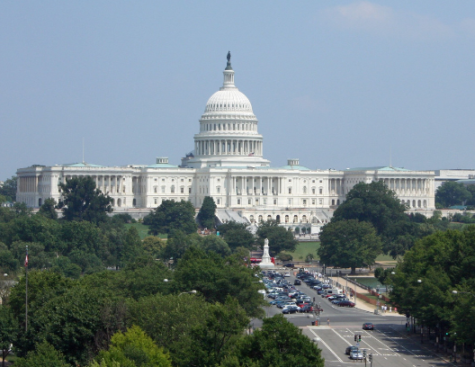Back From the Past and Into the Future
We took a look at the events that were occurring around the world during 2012, when the graduating seniors were only freshmen, and then asked what they think the world will look like in another four years.
Democracy not Deserted
By Sean Lopez
As a result of decades of police brutality, harsh living conditions, and a lack of fundamental rights, the Arab Spring began in 2012. This widespread revolt polarized much of the population, creating factions devoted to ending their government. As time went on, the revolts became and were met with stern opposition.
The first revolt of the Arab Spring occurred in Tunisia when local police took 26-year-old Mohammed Bouazizi’s cart and beat him bloody with bludgeons for not having a permit for it. He traveled to the municipal courts to accuse the policemen of brutality, but his claims were ignored. To protest, Bouazizi set himself on fire right outside the courts, igniting the long boiling frustrations of the Arab world. More demonstrations and violent revolts occurred across the country, and they soon spread to other Arab countries, most notably Egypt.
Protesting poverty and the state of emergency, which legalized martial law and allowed arrest without questioning, Egyptians organized a demonstration for Police day, symbolizing the death of British officers in 1952, which sparked anti-British sentiment within the populace. These demonstrations started in Cairo, and soon sprang across the country; the worst of this violence happened in Tahrir Square. These revolts met bitter opposition from armed government troops on horseback. When these methods didn’t work, the government then framed the protesters as foreign agents to destroy their support groups. Yet this only strengthened them. This protest saw a huge increase in solidarity; as members of different religions protected each other during the violent revolts. Muslims were even seen protecting Christians during their day of Sunday service, a true mark of unity. Traditional gender relations also saw a huge improvement.
Aljazeera Correspondent Fatima Naib said, “Egyptian women, just like men, took up the call to ‘hope.’ Here they describe the spirit of Tahrir — the camaraderie and equality they experienced — and their hope that the model of democracy established there will be carried forward as Egyptians shape a new political and social landscape.”
This, along with the newfound brotherhood between the religions, proved that the revolts could be constructive and productive and didn’t have to be meaningless blood baths.
Four years ago, the Arab Spring began, and now many have honest hope for change to a more democratic and accepting society.
Malala: Shot, not Stopped
By Sean Lopez
Four years ago, a 14 year-old girl named Malala Yousafzai was shot in the head at point blank range. She had received attention on a global scale after she was enrolled in school five years prior, and began speaking out for women’s rights in Pakistan. After the assault had taken place, Malala became an advocate for gender equality across the globe and began a peaceful effort to inspire and to educate young women around the world. Since 2012, the year she was shot, Malala has become an activist for women’s right to an education; she has given several speeches, as well as founded the Malala Fund, which spreads awareness and helps to fight against the issue of gender inequity. In 2014, she was co-awarded the Nobel Peace Prize for her efforts. She is now 18 years old and continues to stand up for education rights and to encourage change. Since the shooting, she has promoted education rights throughout the world with passion, sparking both a social change in certain locations around the world, as well as a change in the ideologies of many people. With Malala and others advocating for equal rights, we can look forward to a lifetime of progress.
An Underwhelming “End”
By Ella Ban
May 27th, 2012—Minister Ronald Weinland predicted the end of the world would be heralded by Jesus Christ’s return to Earth on this Pentecost day. One of the lesser-known doomsdayers, Weinland led a sect of the Church of God, known as the Church of God Preparing for the Kingdom of God (COG-PKG), which claimed to offer support and education about the arrival of Christ. In a twist of fate that surprised no one, the date passed without incident, and Weinland later preached from his highly revered blogspot that; in fact, “nothing has begun in the world that would signal the need or purpose for … Christ’s return” (WLWT). Though he was sentenced to 42 months in prison for tax evasion, he remains head of the COG-PKG (in absentia).
Oddly enough, while much of the religious world was in turmoil over the imminent destruction of the planet, no one thought to contact any biologists or astronomers to verify this is as a possibility. A Q&A published on NASA’s website put it succinctly: “Our planet has been getting along just fine for more than 4 billion years, and credible scientists worldwide know of no threat associated with 2012” (NASA).
This was largely in response to the proposition that the world would end on December 21st, 2012 in conjunction with the end of the 5,126 year-long Mayan calendar. While it’s true that this date marked the of the 13th b’ak’tun, or time period, the Mayans were not a civilization of doomsdayers—in fact, the end of this b’ak’tun would have been a cause for celebration. As the Q&A noted, “Just as the calendar you have on your kitchen wall does not cease to exist after December 31, the Mayan calendar does not cease to exist on December 21, 2012” (NASA).
And while predictions for the end of the world continue with (search for “Doomsday Argument by Cricket Analogy,” “Year 6000” or “Heat death of the universe” for more information), the anti-climactic resolution of 2012 suggests that the fate of the planet may not be so easily prophesized.
Into the Future
The First Lady vs The Financier
By Salem Ali
As President Barack Obama’s term comes to an end, so do his eight influential years as commander and chief. Yet with the close of one chapter comes the start of another, and between the two likely candidates, Hillary Clinton and Donald Trump. Clinton, the former Secretary of State and moderate Democratic nominee, and Trump, a businessman with an anti-establishment and radical agenda, will likely be the two main names on the ballot in November, and the world these two seek to make contrasts greatly.
From the Middle East to military expansion, Donald Trump and Hillary Clinton differ greatly in their foreign policy. While Trump’s declaration to build a wall between the U.S. and Mexico may have been very radical, some of his views are considerably less. Taking troops out of South Korea and Japan, an expansion of the military, and putting ground soldiers in Syria all fall under Trump’s plans.
“We really have no choice, we have to knock out ISIS. I would listen to the generals, but I’m hearing numbers of 20,000-30,000,” said Trump.
Clinton however does not support expanding the military and vows to maintain international alliances(BBC). Senior David Yee believes Clinton’s experience with foreign affairs as Secretary of State gives her an edge in the eyes of many.
“Being the former secretary of state, she would have lots of foreign affair experience. She appeals in the sense that she is experienced and she knows what she’s doing unlike Trump,” said Yee.
In terms of domestic affairs, the two continue on the contrasting patterns. Clinton supports a pathway to citizenship for illegal aliens but Trump does not. Trump is pro-life while Clinton pro-Choice, and Trump agrees with the absolute to gun ownership while Clinton wants restrictions. Obviously, the domestic landscape in this country will vary greatly based on who the next president is (CNN).
From foreign policy to economic and domestic affairs, Trump and Clinton both disagree and agree on many issues, moreso of the former rather than latter. Consequently, whoever is elected as the next president will have an incredibly large impact on not only the U.S., but the globe as well.
Environmental Emergency
By Jessica Tang
Global warming has been a real and present concern for the past decade or so. Much has been said about the tipping point: that it marks a climactic catastrophe for the world; that it will kick-start a series of reactions that will only accelerate the Earth’s entropy; that it will be irreversible — and that this projected tipping point will occur in four years.
If no cutbacks on the number of greenhouse gas emissions are made, then locations around the globe will start hitting the point of no return. Already, half of Australia’s Great Barrier Reef is dead or dying — a huge blow to the biodiversity of the ocean, and a warning sign that the temperature and the acidity of the ocean are rising dangerously high. If this does not affect the plankton most organisms depend on, it will certainly cause low oxygen dead zones to expand. As temperatures rise, most organisms require more oxygen to function; in conjunction with the decreasing amounts of oxygen in the water, the habitable zones of the ocean are steadily shrinking.
Climate change has also seen a rise in ocean levels and coastal flooding. Already, the Pacific Ocean has swallowed five Solomon Islands along with various villages and atolls. Here in America, the East Coast has particularly been experiencing problems. Due to geological problems, the land along the East Coast is sinking, and the sea levels along nearly the entire coast are rising (LiveScience). In four years, the Earth may see changing and increasing tides and floods along with its myriad changing weather patterns.
All in all, the consequences of global warming may reach its turning point by 2020. Tropical zones, more sensitive to temperature changes, will start suffering climate catastrophe, with the rest of the world following by the year of 2047, with North Africa and Middle East forecasted to be uninhabitable by the mid-century according to Max Planck Institute for Chemistry and the Cyprus Institute. The coming years, if they follow the trends set by 2015 and 2016, may be the hottest years the Earth has seen in centuries.
“The earth is kind of a delicate place to live,” said senior Hannah Haakenson. “People don’t really respect the earth like we should. People don’t treat in a way that it can thrive, so in four years I think that things are just going to go downhill.”
The world that the senior class is set to inherit may not be sustainable. Change must be made quickly for the Earth to last.
A Look into the Future
By Salem Ali and Omar Khan
Virtual Reality (VR) is one of the prototypical examples of how advanced technology has become: it essentially recreates an atmosphere through intense visual stimuli that creates a new frontier for both entertainment and technology. Senior Will Lewczyk describes what VR is.
“Virtual Reality is a 3D computer-generated simulation of a real environment. It can be used to view areas that are far away, to generate a new environment, and to immerse a person into a videogame,” said Lewczyk.
As the VR industry has evolved from infancy, the amount of companies involved has exponentially increased. While some companies had their start-up roots based in VR, like Oculus, some have jumped into the VR market only relatively recently. Samsung, HTC, and Valve have released their own iteration of a VR headset.
Current uses for VR are mostly centered around entertainment: consumers can strap into the headset and play games that more fully immerse the user in the virtual world. As the user moves their head, the display moves accordingly in real time, providing a relatively accurate simulation.
Cole Hopkins, a junior, owns a Samsung VR, and thinks that the uses of it will change in the future.
“I think as time goes on, [VR] will be more and more for educational purposes and science instead of what it is now,” said Hopkins.
While VR is mostly used for entertainment purposes, its potential is unfathomable: it provides entrepreneurs with a medium for technological creativity.
“VR will not die out. It will be easily accessible and applied to everyday life. The benefits of VR should appeal to entrepreneurs and encourage more people to invest in VR companies and motivate more people to enter the field and continue innovations in the field,” said Lewczyk.






